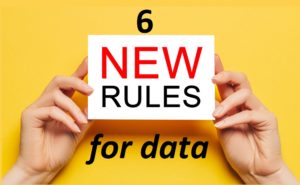
The Six New Rules of Data

(Daria-Lukoiko/Shutterstock)
Ajeet Singh, the co-founder and executive chairman of ThoughtSpot, may have resembled Doc Brown more than Moses. But that didn’t stop him from handing down six new rules of data yesterday at the Beyond 2022 conference.
Singh, who walked out on stage Tuesday dressed as the wacky mad scientist from Back to the Future, shared his perspective on data during his keynote address here at the Wynn Resort in Las Vegas, Nevada.
1. Leverage best of breed from the modern data stack
“It’s easy to fall into a trap of good enough technology from a single vendor,” Singh said “But that will really limit the returns you can get from all the hard earned money you’re putting into cloud and data. Instead, let us use the best technology from every layer of the modern data stack.
It was a lot harder in the bad old days of data to change out horses midstream. But in the cloud, it’s much easier to replace a vendor in the stack with another, since everything is a service, he said. “So you can really have the best of both worlds – the best technology for every part of your stack and ease of integration,” he said.
2. Empower everyone with self-service analytics
Instead of feeding users insights that are created by experts, let everyone loose on the data, Singh says. This is part and parcel of ThoughtSpot’s mantra, of course, but as mantras go, they bear repeating.
“I’m pretty sure that many of you have very large teams of analysts that are answering questions from the business or building more dashboards,” Singh said. “Let me ask you – do you really think they should keep doing the same job in the coming decade? How do you expect to move your business forward, transform your business, if your own teams are not evolving?”

Ajeet Singh, ThoughtSpot executive chairman, presents the six new rules for data at Beyond 2022 on May 10, 2022
Everything in the consumer world has become self-service, he said–food, entertainment, travel. With search and AI powering data self-service, it’s time that business data followed.
And in the cloud frankly there’s not a choice, because the data volumes are so high, and the questions from the business are coming fast and furious,” Singh added. “They really want it all and they want it right now and you have to enable self-service for them to be able to make their own decisions.”
3. Operationalize insights for action
Insights are powerful, but they’re only as good as the actions they drive, Singh said. And dashboards, which ThoughtSpot loves to hate, simply don’t cut it anymore.
“You can’t really leave it to people to keep looking at dashboards all the time to find insights,” he said. Besides, in the cloud, insights flow across difference services in the stack. “They can go from cloud data platform to BI tools to your operational systems where people are running execution,” he said.
4. Build a flexible data foundation
Users should have the flexibility and freedom to pick the data platform that works best for their business needs, Singh said.
“Those of you who have been in the industry for a couple of decades know that trying to build this uber perfect data warehouse that meets the needs of everyone and is perfectly modeled–that doesn’t work,” he said. “What also doesn’t work is taking all the data and dumping it into a data lake and hoping that insights will come out that you can use by your business.”
As companies make the move to the cloud, they should look for a data foundation that offers governance, structure, and automation, Singh said.
“In the cloud, with modern tools, modern data engineering tools, programable data models, it is possible to achieve the best of both worlds,” he said.
5. Utilize third party data to build a 360 degree view
Your internal data is a great starting point. But to really drive the maximum benefit from data systems, you’re going to need some third-party data, Singh said.
“It’s like the difference between driving a car by looking at the old map that you had on paper [versus] driving a car by a using a service like Google Maps, which is continuously giving you the traffic patterns so that it can navigate properly,” the ThoughtSpot executive chairman said. “Third party data is like the…signals that are coming from all the other cars that are being curated by a third party.”
The cloud makes it easier than ever to obtain third part data. “It’s also very easy to consume in the cloud through APIs,” Singh said. “So if you bring third party data into your business processes, your business leaders can make better decisions.”
6. Deliver engaging, data-driven user experience
When you’re thinking about building business applications, don’t think about it as just a system of record, a place to capture and store information, Singh said. Rather, think of it as a system of engagement that can be bolstered with a healthy helping of data.
“If you look at how I use my Fitbit, it definitely tracks how many steps I’ve taken and it also stores how many hours I slept last night,” he said. “But it goes way beyond that. It is continuously monitoring so many signals for me.”
Use that Fitbit model when you’re building a new application, Singh said. Instead of building the same-old HR app that tracks attendance or benefits, think of it as a data-driven application app where you can engage your employees in new ways.
“If you embrace data as a new UX, you can build applications that will be a lot more [engaging]… and will drive better adoption.”
Related Items:
ThoughtSpot Prepares for Next Decade of Data
Data Going to Waste, WANdisco Says
Five Ways Big Data Projects Can Go Wrong (And What You Can Do About Them)






























